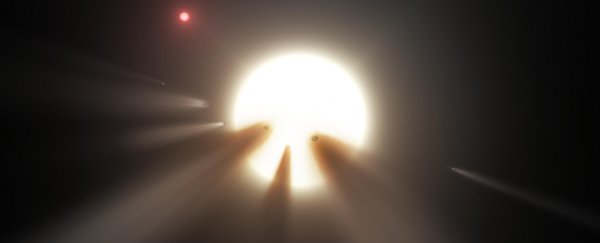Mysterious star KIC 8462852 that has been confounding astronomers since its 2015 discovery is continuing to do so, as spectacularly as only KIC 8462852 can.
According to all-sky survey records examined by researchers at Carnegie Mellon University, the star exhibited strange behaviour over 10 years ago, too - which means current theories about it just had a massive spanner thrown in the works.
KIC 8462852, around 1,500 light-years away, is also known as Tabby's Star or Boyajian's Star after Tabetha Boyajian, the Yale astronomer who first brought the star's unusual behaviour to light in 2015. She noticed that the star's light was dimming very strangely.
The Kepler telescope spends its days looking for dimming stars - a dimming pattern is how we find exoplanets. When a planet passes between us and its host star as it orbits, the light of the star dims from our perspective.
Exoplanet dimming is regular and periodic and limited. But KIC 8462852's dimming is irregular, and the amount it dims varies. Its most recent dimming occurred in September this year, dropping 3 percent, but it has also been observed dropping by 22 percent. There is no discernible pattern to the star's fluctuations in brightness.
KIC 8462852 also seems to have been on a very slow fade, dimming gradually over time. Yet an analysis that included a century's worth of data found that this was not the case, and now the Carnegie researchers have found something else: KIC 8462852 has significantly brightened in the past, too.
Researchers examined 11 years worth of data from All Sky Automated Survey (ASAS) and about 2 years worth of more recent data from the high-precision All-Sky Automated Survey for Supernovae (ASAS-SN).
They found that the star has, in fact, been dimming since February 2015, and is now 1.5 percent dimmer than it was then.
But they also found that the star had two periods of significant brightening, one in 2007 and another in 2014.
"Up until this work, we had thought that the star's changes in brightness were only occurring in one direction - dimming," researcher Josh Simon explained. "The realisation that the star sometimes gets brighter in addition to periods of dimming is incompatible with most hypotheses to explain its weird behaviour."
These theories include a ringed planet passing in front of the star, either absolutely enormous or a smaller one with an orbital wobble; a swarm of comets; space junk; aliens (???); the star swallowing a planet; something happening inside the star itself; and the scientific equivalent of a shrug emoji.
New research led by Huan Meng of the University of Arizona, published in The Astrophysical Journal, just proposed that the dimming may actually be due to an irregular cloud of dust - because there's less dimming in the infrared light than the ultraviolet light, and anything larger than dust would block all light.
"This pretty much rules out the alien megastructure theory, as that could not explain the wavelength-dependent dimming," Meng said. "We suspect, instead, there is a cloud of dust orbiting the star with a roughly 700-day orbital period."
If it is dust, the star will get redder when it dims, which would be consistent with the dust theory, so that's what Carnegie co-researcher Benjamin Shappee believes the next step should be.
"That information would help narrow down the possible explanations for why this star is doing such strange things," he said.
You can follow the quest to understand Tabby's Star on the Twitter hashtag #TabbysStar.
Simon and Shappe have submitted their research for publication in AAS Journals, and it can be read online at preprint resource arXiv.
